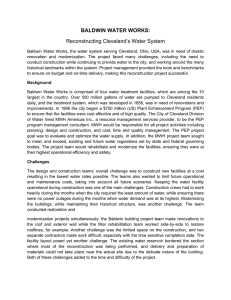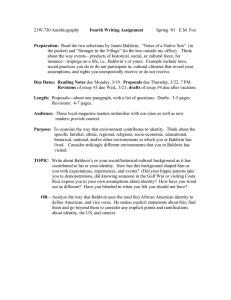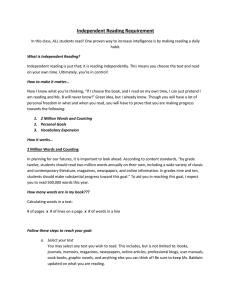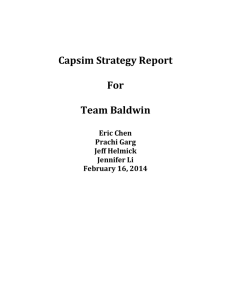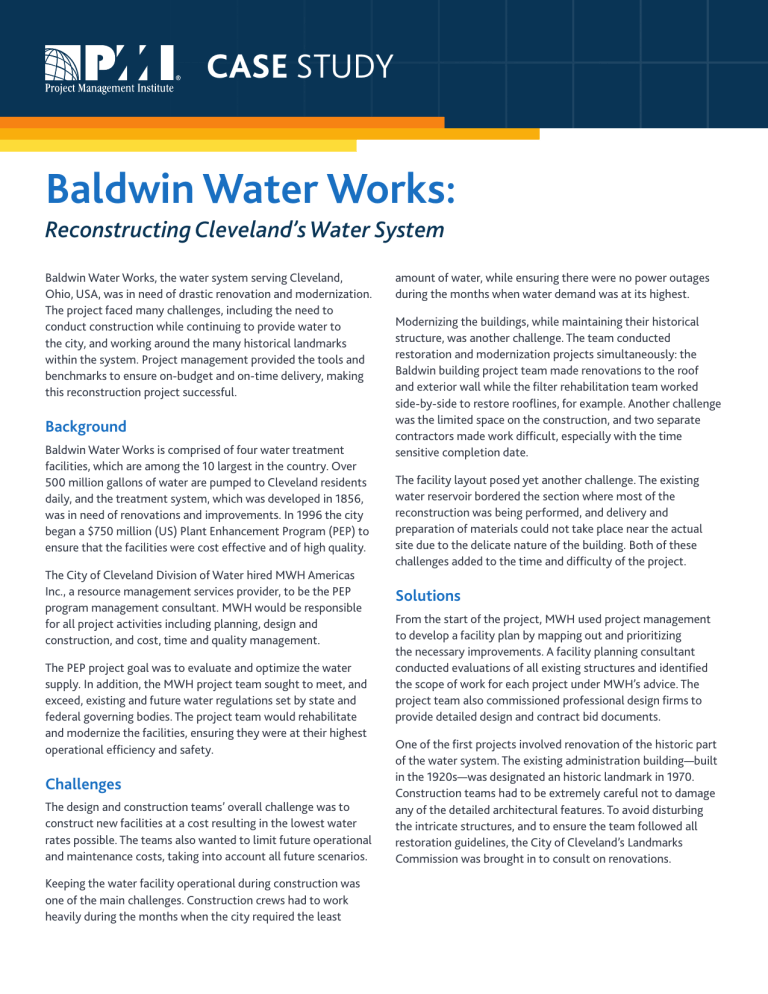
Baldwin Water Works CASE STUDY Baldwin Water Works: Reconstructing Cleveland’s Water System Baldwin Water Works, the water system serving Cleveland, Ohio, USA, was in need of drastic renovation and modernization. The project faced many challenges, including the need to conduct construction while continuing to provide water to the city, and working around the many historical landmarks within the system. Project management provided the tools and benchmarks to ensure on-budget and on-time delivery, making this reconstruction project successful. Background Baldwin Water Works is comprised of four water treatment facilities, which are among the 10 largest in the country. Over 500 million gallons of water are pumped to Cleveland residents daily, and the treatment system, which was developed in 1856, was in need of renovations and improvements. In 1996 the city began a $750 million (US) Plant Enhancement Program (PEP) to ensure that the facilities were cost effective and of high quality. The City of Cleveland Division of Water hired MWH Americas Inc., a resource management services provider, to be the PEP program management consultant. MWH would be responsible for all project activities including planning, design and construction, and cost, time and quality management. The PEP project goal was to evaluate and optimize the water supply. In addition, the MWH project team sought to meet, and exceed, existing and future water regulations set by state and federal governing bodies. The project team would rehabilitate and modernize the facilities, ensuring they were at their highest operational efficiency and safety. Challenges The design and construction teams’ overall challenge was to construct new facilities at a cost resulting in the lowest water rates possible. The teams also wanted to limit future operational and maintenance costs, taking into account all future scenarios. Keeping the water facility operational during construction was one of the main challenges. Construction crews had to work heavily during the months when the city required the least amount of water, while ensuring there were no power outages during the months when water demand was at its highest. Modernizing the buildings, while maintaining their historical structure, was another challenge. The team conducted restoration and modernization projects simultaneously: the Baldwin building project team made renovations to the roof and exterior wall while the filter rehabilitation team worked side-by-side to restore rooflines, for example. Another challenge was the limited space on the construction, and two separate contractors made work difficult, especially with the time sensitive completion date. The facility layout posed yet another challenge. The existing water reservoir bordered the section where most of the reconstruction was being performed, and delivery and preparation of materials could not take place near the actual site due to the delicate nature of the building. Both of these challenges added to the time and difficulty of the project. Solutions From the start of the project, MWH used project management to develop a facility plan by mapping out and prioritizing the necessary improvements. A facility planning consultant conducted evaluations of all existing structures and identified the scope of work for each project under MWH’s advice. The project team also commissioned professional design firms to provide detailed design and contract bid documents. One of the first projects involved renovation of the historic part of the water system. The existing administration building—built in the 1920s—was designated an historic landmark in 1970. Construction teams had to be extremely careful not to damage any of the detailed architectural features. To avoid disturbing the intricate structures, and to ensure the team followed all restoration guidelines, the City of Cleveland’s Landmarks Commission was brought in to consult on renovations. Baldwin Water Works Project management techniques helped plan for and incorporate space limitations into the project plan: ■■ delivery of the 2,500 tons of 20 inch by 48-inch ductile iron piping needed for the project was scheduled on an asneeded basis; and ■■ construction crews cut through a 24-inch thick concrete wall 28 feet below ground level to route all materials to combat the limited space for the delivery and preparation of materials. The team closed the opening at the completion of the project. Project management techniques also helped identify and mitigate possible complications related to the modernization of the project. As part of the renovation, the plant’s operational staff transitioned from a manual mode to a state-of-the-art PLC-based operating system. To make this transition smoother, the team provided training classes and hands-on assistance for all employees. This allowed the team to quickly and efficiently implement the new systems. Results The team scheduled a complete plant closure to remove and replace all piping and valves. Although the contract allowed for a 10-day closure, the project took only four days due to the detailed planning and coordination of teams. The team managed the project with the owner’s best interests in mind, meeting and exceeding expectations. The project was kept on-time and on-budget, with minimal risk and liability. The owner saved over US$2.8 million on the project, which was allocated to other projects within the city. Key Achievements ■■ project completed US$2,884,075 (10.7 percent) below awarded contract amount; ■■ reached all milestones on or ahead of schedule; ■■ repairs on all filters completed eight months early due to communication and scheduling of specific deadlines throughout project; and ■■ received multiple awards, including American Public Works 2004 Project of the Year. 2 © 2012 Project Management Institute, Inc. All rights reserved. “PMI” and the PMI logo are marks of Project Management Institute, Inc For a comprehensive list of PMI marks, contact the PMI Legal Department. ORG-6029-2011(01-12)
